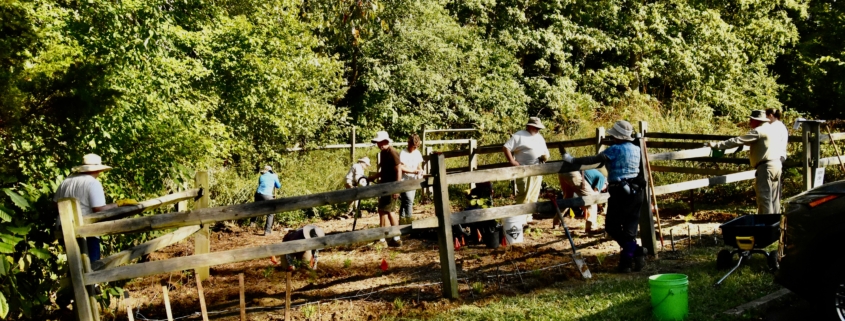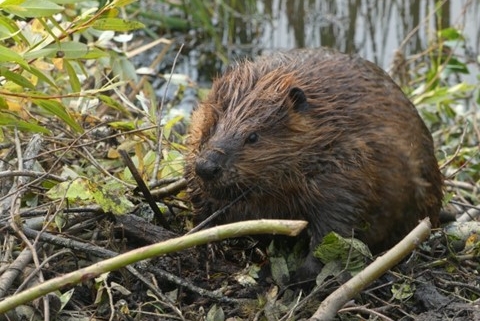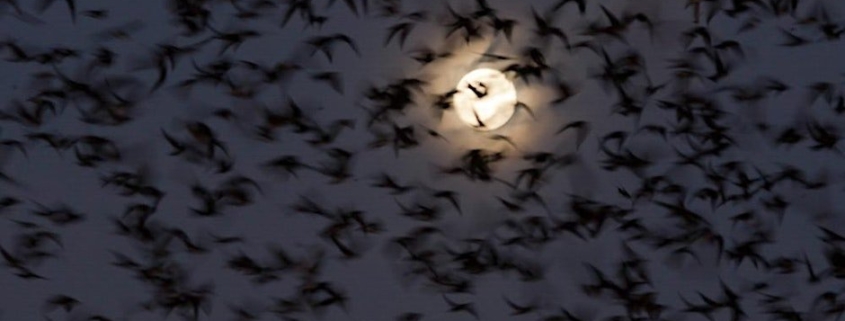Article and photos by FMN Katy Johnson, except as noted
I am writing this article in hopes to inspire you to become more aware of what is happening in your neighborhoods and to raise your hand to do what you can to help preserve our local flora and fauna.
My Master Naturalist journey began by joining the Virginia Native Plant Society’s Native Plant Rescue headed up by the Potomac Chapter VNPS Grass Bunch and Friends of Accotink Creek. I like to joke and say Alan Ford suggested I become a Master Naturalist because he was tired of me following him around asking questions. I appreciated the opportunity to learn and took his advice. The project took longer than was expected and I was able to get through my FMN Training, had enough hours upon graduation to become Certified and became a Site Leader. The site became my Walden Pond. I was able to spend countless number of hours there, observing and studying all that existed in this small patch of nature.

FMN Katy Johnson with rescued Jack-in-the-pulpit, photo by Laura Beaty
When the site eventually closed to be developed, I started reading Fairfax City Council meeting agendas to become aware of projects being proposed and other opportunities to rescue our native plants. The City’s Stream Restoration seemed like a great opportunity. I reached out and contacted our Publics Works Program Manager and later found out Friends of Accotink Creek had also reached out asking again to rescue the native plants in the disturbance area ahead of the project. We were granted access to the site and have been heading up weekly rescues for over a year now.
Because of the enormous area to be disturbed, and need to find homes for the relocated plants, we decided it would be a good opportunity to create a Native Plant Demonstration Area to show the importance of Invasive Removal. We chose a site at a very prominent park in the City that would be able to demonstrate the difference of a healthy habitat and one that has been smothered in invasives. We removed the carpet of invasives and replanted with the native rescues. The difference is obvious even to passive observers. We were then able to get the site adopted as a Pilot for the Adopt a Spot Program and it is now being maintained.
Inspired by a Rod Simmons VNPS Program on Golden Rods, we decided that the local ecotypes of plants should be eventually returned back to the area after the stream restoration. We reached out to the City’s Urban Forester with the idea, who walked the site with us and identified specific species she would like to save. We have identified hundreds of native seedlings to be saved and eventually be relocated back to the site. We have been saving plants in our yards and are working with the City to hopefully establish a Native Plant/tree Nursery.

Phil Latasa at native plant giveaway
By being aware and working with our City, thousands of native plants have been rescued. Many were set aside for use in other City parks and projects. We were able to give away hundreds of plants at City events such as Earth Day and HisTree to educate the public about the importance of native plants, and to get them started on their native plant journey. The plan is to return as many local ecotype species as we have rescued back to where they came from after the stream restoration.
Because of our involvement and the relationship we had established with the City, the Public Works Program Manager for the Ashby Pond Dredging Project reached out to myself and Philip Latasa of Friends of Accotink Creek last year to see if there were native plants to rescue in the disturbance area of the Dredging Project. On our walk to identify plants, I asked “What about the turtles?” His response was “What turtles?” I said “The giant turtles that live here.” Philip mentioned a similar project in Manassas that had rescued a number of turtles ahead of a pond’s draining. Philip passed along more information about the Lucasville Pond Retrofit in Manassas. The City then contracted Dr. Todd Rimkus of Hawksbill Hope, a Turtle Conservation Non-Profit. Dr. Rimkus had participated in the Manassas rescue. I offered to be the Volunteer Coordinator for the Rescue.

Dr. Rimkus with snapping turtle
Volunteers from Fairfax Master Naturalists and the community, were able to observe and assist as Dr. Rimkus and his team pulled traps that were baited with raw chicken legs. The largest turtle caught measured in at 18 inches and an estimated 40 pounds. So far, 58 turtles, snapping, painted and a river
cooter that would have otherwise been destroyed have been rescued. The snapping and painted turtles have been tagged and safely relocated to ponds identified by Dr. Rimkus that could support them, but

Inserting the tracking device
do not currently have a turtle population. Download a video taken by Dr. Rimkus of a big snapper being released. The river cooter will be held by Dr. Rimkus until the Project’s completion and then returned to Ashby Pond. The project has been paused due to empty traps and high temperatures. There have been a few turtle sitings reported at the pond so the project will continue on a smaller scale when the weather is more conducive.
I hope my Naturalist Journey will inspire you to reach out and create your own opportunities to do what you can do!


















